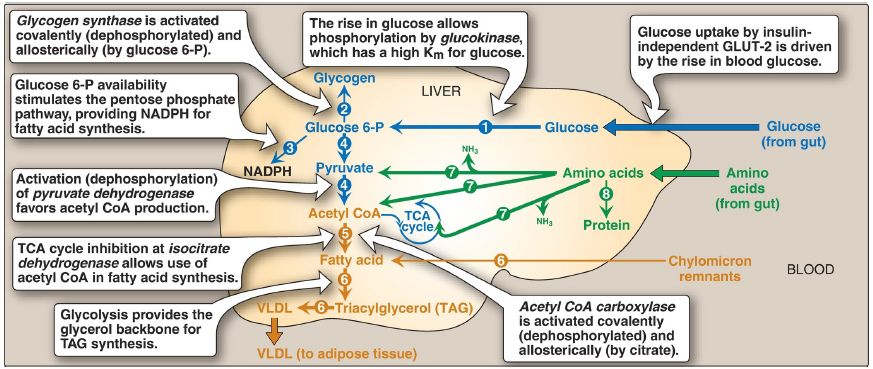


 النبات
النبات
 الحيوان
الحيوان
 الأحياء المجهرية
الأحياء المجهرية
 علم الأمراض
علم الأمراض
 التقانة الإحيائية
التقانة الإحيائية
 التقنية الحيوية المكروبية
التقنية الحيوية المكروبية
 التقنية الحياتية النانوية
التقنية الحياتية النانوية
 علم الأجنة
علم الأجنة
 الأحياء الجزيئي
الأحياء الجزيئي
 علم وظائف الأعضاء
علم وظائف الأعضاء
 الغدد
الغدد
 المضادات الحيوية
المضادات الحيوية|
Read More
Date: 25-11-2021
Date: 16-12-2021
Date: 13-9-2021
|
Liver : Amino acid Metabolism
1. Increased amino acid degradation: In the absorptive period, more amino acids are present than the liver can use in the synthesis of proteins and other nitrogen-containing molecules. The surplus amino acids are not stored but are either released into the blood for other tissues to use in protein synthesis or deaminated, with the resulting carbon skeletons being degraded by the liver to pyruvate, acetyl CoA, or TCA cycle intermediates. These metabolites can be oxidized for energy or used in FA synthesis (Fig. 1, ). The liver has limited capacity to initiate degradation of the branched-chain amino acids (BCAA) leucine, isoleucine, and valine. They pass through the liver essentially unchanged and are metabolized in muscle .
2. Increased protein synthesis: The body does not store protein for energy in the same way that it maintains glycogen or TAG reserves. However, a transient increase in the synthesis of hepatic proteins does occur in the absorptive state, resulting in replacement of any proteins that may have been degraded during the previous period of fasting (Fig. 1, ).
 Figure 1: Major metabolic pathways in the liver in the absorptive state. [Note: The acetyl coenzyme A (CoA) is also used for cholesterol synthesis.] The numbers in circles, which appear both in the figure and in the text, indicate important pathways for carbohydrate, fat, or protein metabolism. Blue text = intermediates of carbohydrate metabolism; brown text = intermediates of lipid metabolism; green text = intermediates of protein metabolism; P = phosphate; TCA = tricarboxylic acid; VLDL = very-low-density lipoprotein; GLUT = glucose transporter; NADPH = nicotinamide adenine dinucleotide phosphate; NH3 = ammonia.
Figure 1: Major metabolic pathways in the liver in the absorptive state. [Note: The acetyl coenzyme A (CoA) is also used for cholesterol synthesis.] The numbers in circles, which appear both in the figure and in the text, indicate important pathways for carbohydrate, fat, or protein metabolism. Blue text = intermediates of carbohydrate metabolism; brown text = intermediates of lipid metabolism; green text = intermediates of protein metabolism; P = phosphate; TCA = tricarboxylic acid; VLDL = very-low-density lipoprotein; GLUT = glucose transporter; NADPH = nicotinamide adenine dinucleotide phosphate; NH3 = ammonia.



|
|
|
|
دراسة: حفنة من الجوز يوميا تحميك من سرطان القولون
|
|
|
|
|
|
|
تنشيط أول مفاعل ملح منصهر يستعمل الثوريوم في العالم.. سباق "الأرنب والسلحفاة"
|
|
|
|
|
|
|
لتعزيز التواصل مع الزائرات الأجنبيات : العتبة العلويّة المقدّسة تُطلق دورة لتعليم اللغة الإنجليزية لخادمات القسم النسويّ
|
|
|